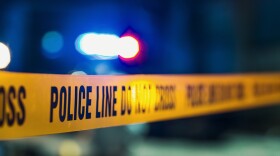Imagine it’s pitch dark out and you’re driving down a road in the middle of nowhere. Then, you see an abandoned structure and you decide to go exploring.
That’s what Chris and Katie Robleski do with their night photography. They call themselves The Flash Nites, and for half of the year they’re out investigating abandoned structures in the dark and illuminating history.
With just a full moon, a flashlight and long exposure photography, they turn lost Americana into unique art — usually while trespassing.

Chris says he didn't intend for his nighttime photography to become his job, but the reaction they get from people at art fairs or connecting online is "humbling."
"15 years ago I was just kind of wanting a challenge and needed to get out," he explains. "I had lost my parents and I'd thought what better way to go out at night with a flashlight in the freezing cold? I like the challenge of it."
Five years after that, Chris and Katie met online and she was immediately intrigued by his art.
“We got into this train yard, he gave me this Vivitar flash and a little purple gel over the top. And he’s like, ‘Head on into the train and then just keep pressing this button.' And so I did, and I came out of the train, looked at his little LCD screen on his camera and I was just hooked,” Katie recalls.
Chris is the one behind the camera in charge of composition and Katie serves as the light painter. "I go inside [these places or objects] and I go from room to room to room just lighting up each of the rooms," Katie explains. "So ... depending on how much ambient light we have it can be a minute to five minutes [to capture the shot]."
While Katie and Chris are out traveling in search of lost and abandoned gems, they say they rely on a mix of Google earth, getting tips and pointers from locals and sometimes just happening upon the structures. When The Flash Nites aren't on the road capturing photos, they're traveling to art shows and fairs.
"It's the perfect six month to six month kind of repetitious cycle that we do," notes Katie. "You're just kind of wiped by the end of the [art show] season, but then we transition into the shooting all winter and it is quite the nice balance."
From capturing urban archaeology to rural America, rusting vehicles and album covers, Chris says that people's biggest misconceptions of their art is that they assume it's heavily edited.
"Occasionally we'll get the scoff where ... they think it's Photoshop and they walk away but I can't catch up to them and say, 'No, no, no! We're just using moonlight and light.' So that's basically all of our work is just flashlight, moonlight and a lot of patience."









